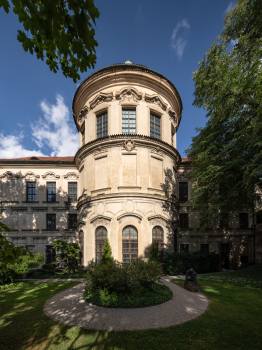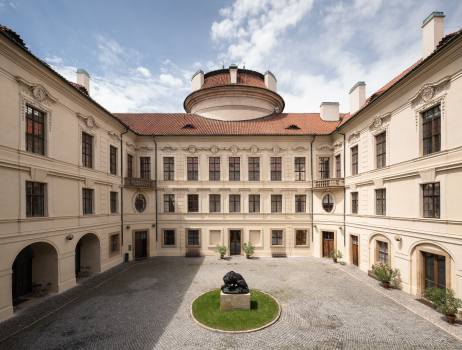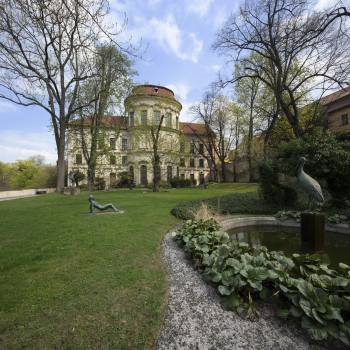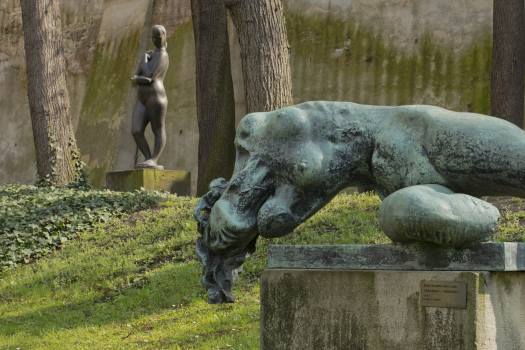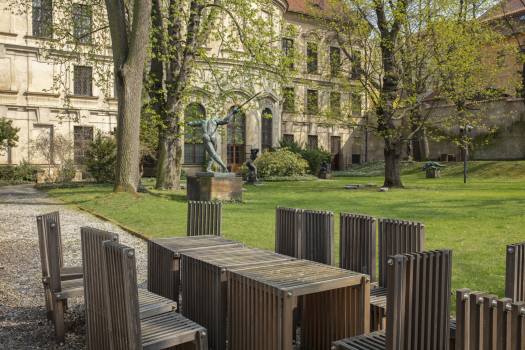Since 1947, Sternberg Palace has been home to masterpieces of National Gallery Prague whose predecessor, the Picture Gallery of the Society of Patriotic Friends of the Arts, had been located there in the 19th century.
The palace was commissioned by the imperial count Wenzel Adalbert of Sternberg (1643–1708), a descendant of one of the oldest aristocratic families and as such, one of the most powerful Bohemian magnates. In 1690 he purchased the estate adjoining Prague’s Archbishops’ Palace. The topographically complicated site, steeply sloping down to the Stag Moat, featured an earlier house of medieval origin. The new owner immediately started planning a large residence. Built between 1699 and 1708, the palace is attributed to Giovanni Battista Alliprandi. Upon Sternberg’s death in 1708, the palace was only partly completed.
Until 1811, the palace was held by the family trust, with the Society of Patriotic Friends of the Arts housed there. The Society sold the building in 1871. For several years, the palace was used as a psychiatric hospital and from World War I it served the army. After World War II it became the seat of the newly constituted National Gallery.
Even though only fragments of the original decoration have remained, Sternberg Palace is a first-rate jewel of High Baroque architecture in Prague. Both the building and its furnishings combine diverse art forms, creating the perfect space for artworks of miscellaneous styles and times.
1—1 / 5
Permanent exhibitions
Sternberg Palace Garden
The hidden treasure of Sternberg Palace is the garden, which is a peaceful green oasis in the centre of the busy tourist scene. Its small size creates an intimate natural corner inviting you to relax and refresh.
The garden is picturesquely situated at the edge of the Stag Moat, overlooked by a low parapet. It occupies the width of one palace wing and takes the form of a rectangle facing west, i.e., towards the Loreta. It is into this garden that the main façade of the palace opens, which in the central axis is penetrated by a massive avant-corps with a large hall (the so-called rotunda) on the first floor and the former garden hall (sala terrena) on the ground floor. In the centre of the elevated oval avant-corps with a mansard roof is the coat of arms of the Sternbergs above the blind windows. The impressive composition of the garden façade is best appreciated from the view of the pond, which is decorated with a larger-than-life stork sculpture by sculptor Jan Lauda.
The original Baroque form of the garden is unknown. However, when the Sternberg Palace passed from the ownership of the army to the National Gallery in Prague in 1947, its employees, as it is written in the contemporary correspondence, “with great effort and enthusiasm, adapted it to a very nice condition”. Together with the gallery, the garden was opened to the public. According to oral tradition, the granddaughter of the first Czechoslovak president, Tomáš Garrigue Masaryk, the art historian Anna Masaryková, who worked at the National Gallery from 1945 to 1970, took care of it and planted several rhododendrons herself.
At present, several solitary, large format sculptures are presented among the trees. The selected examples of Czech modern sculpture resonate interestingly with the Baroque palace architecture and together with the natural environment create a unique whole.
The garden is open from April to September and can be visited during the palace opening hours.
The garden is picturesquely situated at the edge of the Stag Moat, overlooked by a low parapet. It occupies the width of one palace wing and takes the form of a rectangle facing west, i.e., towards the Loreta. It is into this garden that the main façade of the palace opens, which in the central axis is penetrated by a massive avant-corps with a large hall (the so-called rotunda) on the first floor and the former garden hall (sala terrena) on the ground floor. In the centre of the elevated oval avant-corps with a mansard roof is the coat of arms of the Sternbergs above the blind windows. The impressive composition of the garden façade is best appreciated from the view of the pond, which is decorated with a larger-than-life stork sculpture by sculptor Jan Lauda.
The original Baroque form of the garden is unknown. However, when the Sternberg Palace passed from the ownership of the army to the National Gallery in Prague in 1947, its employees, as it is written in the contemporary correspondence, “with great effort and enthusiasm, adapted it to a very nice condition”. Together with the gallery, the garden was opened to the public. According to oral tradition, the granddaughter of the first Czechoslovak president, Tomáš Garrigue Masaryk, the art historian Anna Masaryková, who worked at the National Gallery from 1945 to 1970, took care of it and planted several rhododendrons herself.
At present, several solitary, large format sculptures are presented among the trees. The selected examples of Czech modern sculpture resonate interestingly with the Baroque palace architecture and together with the natural environment create a unique whole.
The garden is open from April to September and can be visited during the palace opening hours.
1—1 / 7





